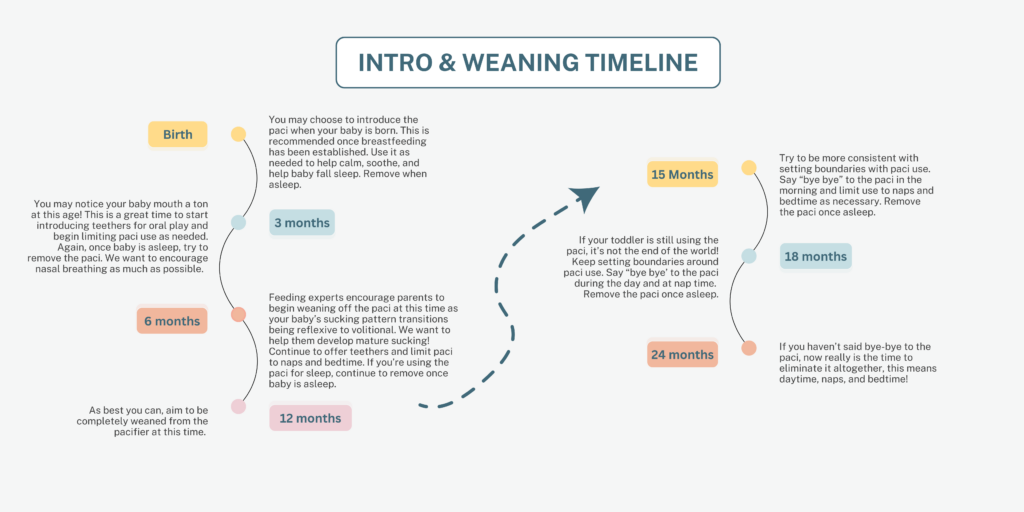Are you wondering how to wean your baby or toddler off the pacifier? For some families, it may be quite simple. And for others the process may not be so linear. But commitment, consistency, and patience will go a long way. And with my guidance, you can get there!
Pacifier Weaning Timeline
Feeding experts typically encourage parents to begin weaning off the pacifier at 6 months and completely eliminate it at 12 months. The timeline is what would be considered, ‘ideal.’ However, some babies and toddlers can be quite expressive and persistent that they still very much want their pacifier. You may also find it to be very helpful tool too, especially, when it comes to sleep!
The following timeline is for you if you have a child older than 12 months.

How do You Wean Off the Pacifier?
Sometimes weaning is really simple, other times, not so much! Below you can find 6 ways you can help your baby or toddler wean off the pacifier. You may choose to use one or a combination of the approaches.
| For infants, remove the paci when they are happy, calm, and awake. They really do not need it! |
| Set boundaries around pacifier use. Limit paci use to help calm and soothe baby, and/or around naps and bedtime. Remove the paci once asleep. |
| Provide alternative options when your baby/toddler is awake such as teethers for oral play and/or introduce a lovey. Find my favorite teethers here. |
| You may have heard recommendations for cutting the paci nipple. This may not be the safest option. BUT there is the Fridababy Weaning System that does this for you! The paci becomes progressively shorter and less satisfying! Check it out here. |
| You can read books about saying “bye bye” to the paci to help make the concept more concrete and prepare them for this transition. This is a great option for toddlers! |
| Introduce the Paci Fairy! Using this approach in combination with reading stories and setting boundaries with paci use can be great. Essentially, you create an official “bye bye paci” countdown for the paci fairy to come. This builds up excitement and anticipation to swap out pacis with a special gift (e.g., new toy, lovey). |
Big Feelings with Pacifier Weaning
Some children will use a pacifier and not become attached while others may use it and become totally obsessed! There is a wide range of what we can expect. Every child is so different. When making a plan to wean, it can be helpful to consider your child’s temperament. Are they pretty easy going or are they more spirited and highly sensitive? If you’re thinking the latter, a more gradual approach to weaning may be best compared to a dropping the pacifier cold turkey.
Additionally, if your child is going through a big transition, such as starting daycare, you may want to think about the timing of weaning or the type(s) of boundaries you’d like to set during this transition.
But first, getting comfortable with responding to emotions is important. Big feelings are expected because change is hard! Your child’s feelings are okay AND you can set respectful boundaries. Examples of what this may sound like include:
- “You want your paci, it’s hard when mama takes it away. You can have it at nap time.”
- “You’re frustrated, you really want your paci. Mama is here, do you want a hug.”
- “You’re mad. This feels so unfair. You can have your chewy or lovey. Which do you pick?”
Being committed to weaning and having consistency around boundary setting is key! You can do this!
When to Reach Out For Support with Pacifier Weaning
If your toddler is a pacifier lover, and you’re noticing they’re exhibiting any of of the following signs:
- Mouth breathing while awake and/or asleep
- Tongue thrust
- Excessive drooling – you may constantly be going through bibs!
- Difficulty with solids and progressing to different textures
- Difficulty drinking from an open and/or straw cup
- Difficulty being understand, or producing certain speech sounds clearly (e.g., s, z, t, d, l, n)
…It may be helpful to consult with a feeding therapist such as an SLP (that’s me!) or OT to complete an oral motor feeding evaluation and help you create a personalized plan for ditching the pacifier!
Leave a Reply Cancel reply
serving parents of babies both virtually and in-person!
Proudly Based in Northern Virginia
Visit Our Clinic in Vienna, VA
501 Church St NE, Suite 211
Vienna, VA 22180
301-615-1343
IN-OFFICE Business Hours
Monday - Thursday: 9:00 AM to 4:00 PM
Friday: 9:00 AM to 12:00 PM
Saturday & Sunday: Closed
Mom & Baby Feeding Groups
Date: Bi-weekly Friday Mornings
Time: 10 am EST
Location: In-Clinic | Cost: Free